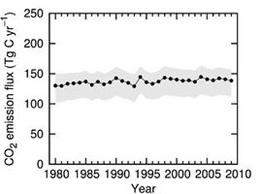Research Abstract
1980-から2009-までの-本の森林における土壌由来の温室効果ガスフラックスの増加傾向
Increasing trends of soil greenhouse gas fluxes in Japanese forests from 1980 to 2009
2011年10月13日 Scientific Reports 1 : 116 doi: 10.1038/srep00116

森林土壌は、温室効果ガス(GHG)のソースまたはシンクとなり、陸域の温室効果ガスの収支に多大な影響を与える。今回我々は、観測データに基づいた広域土壌GHGモデルを用いて、1980~2009年の日本の森林における土壌由来のGHGフラックス(CO2放出、CH4吸収、N2O放出)について、気候変動による変化を見積もった。その結果、日本の森林における土壌GHGフラックスが過去30年にわたって、CO2放出は0.31 Tg C yr−2(1980~2009年の平均との比較では0.23 % yr−1)、CH4吸収は0.40 Gg C yr−2(0.44 % yr−1)、N2O放出は0.0052 Gg N yr−2(0.27 % yr−1)の割合で増加してきていることが明らかになった。また、土壌GHGフラックスに大きな年々変動があることも示された。土壌GHGフラックスの増加傾向と大きな年々変動は、京都議定書における日本のGHG算定と、将来のGHG緩和戦略に相当な影響を与えると思われる。
- 独立行政法人森林総合研究所
- 独立行政法人森林総合研究所 四国支所
- 独立行政法人森林総合研究所 九州支所
Forest soils are a source/sink of greenhouse gases, and have significant impacts on the budget of these terrestrial greenhouse gases. Here, we show climate-driven changes in soil GHG fluxes (CO2 emission, CH4 uptake, and N2O emission) in Japanese forests from 1980 to 2009, which were estimated using a regional soil GHG model that is data-oriented. Our study reveals that the soil GHG fluxes in Japanese forests have been increasing over the past 30 years at the rate of 0.31 Tg C yr−2 for CO2 (0.23 % yr−1, relative to the average from 1980 to 2009), 0.40 Gg C yr−2 for CH4 (0.44 % yr−1), and 0.0052 Gg N yr−2 for N2O (0.27 % yr−1). Our estimates also show large interannual variations in soil GHG fluxes. The increasing trends and large interannual variations in soil GHG fluxes seem to substantially affect Japan’s Kyoto accounting and future GHG mitigation strategies.

